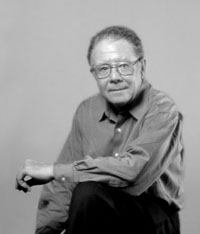

“The only example there is of that old-fashioned entity known as the composer/pianist.” That’s how Easley Blackwood describes himself, and it’s certainly an apt appraisal.
Born in April of 1933, Blackwood studied with (among others) Olivier Messiaen, Paul Hindemith, and Nadia Boulanger. He spent forty years with the University of Chicago, most as Professor. He is also the pianist with the Chicago Pro Musica - a group otherwise made up entirely of members of the Chicago Symphony Orchestra.
His compositions began in the typical way for the mid-fifties, but in 1981, he shifted to a tonal style - for which he was praised, ridiculed, and ignored. Fortunately, history will be able to judge his success in both the studious way, and through listening to recordings of his music.
In February of 1993, shortly after the Chicago Symphony gave the
world premiere of his Symphony #5, I met with Easley Blackwood at
his apartment. Surrounded by scores and other papers, and his kitten,
we chatted about a range of ideas. Portions of this conversation were
used on WNIB, Classical 97 a couple of times, and now I am pleased to present
the entire encounter on this webpage. As usual, names which are links
refer to my interviews elsewhere on my website.
Bruce Duffie: The first thing I want to do is to check a detail. In a couple of the biographical dictionaries, they mention a Fifth Symphony from the mid-’70s. Is that a mistake?
Easley Blackwood: That’s
a mistake, yes. There are four symphonies. The Fourth
is from about 1977 I think.
BD: So the 5th is the new one that the Chicago Symphony did just very recently. How did they get an extra symphony in the older books?
EB: I don’t know where they found it, but other people have mentioned this to me.
BD: You should write to Slonimsky [Editor of Baker’s Biographical Dictionary of Musicians] and a couple of other people, and say, “Hey....”
EB: Well, I suppose I should. But I never find time.
BD: I did a program for the micro-tonal composer Ezra Sims....
EB: Oh, yes. I know him.
BD: ... and he told me that Slonimsky had listed a spurious String Quartet #2, 1964. So in about 1975, Sims wrote a work for woodwind quartet, but called it String Quartet #2, 1964, (both laugh) just to make sure that there would be no error in the book!
EB: [Somewhat amused] That’s one way of dealing with the problem.
BD: Is it good that your biography and work lists are in readily available reference books?
EB: I don’t get any feedback about that. My agent, and the University of course, have material like that, and I think that generally, when people need it, it goes through them.
BD: In recent years you have changed your style of composing. Is this something that happened naturally and gradually, or was this a sudden shift?
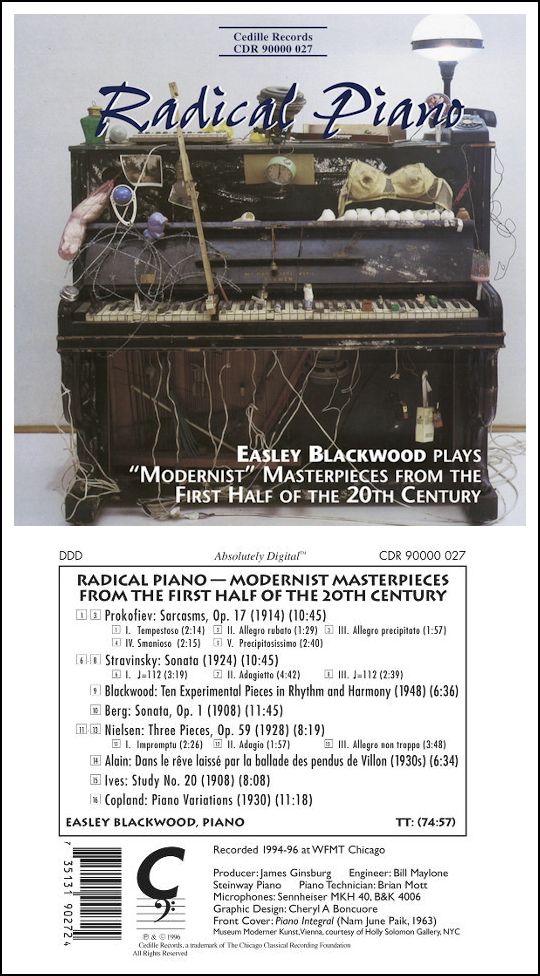 EB: Both, I think. It’s
hard to be sure. The Fourth Symphony, which is a great big
piece for a vastly enlarged orchestra, was a very, very slow proposition
to write, and in the middle of that piece, I wrote a violin sonata, as well.
Let me try to give a little bit of history. There are several pieces
in an idiom that you would call atonal polyrhythmic, including a piece
for small chamber ensemble and soprano on a poem of Baudelaire; a trio
for piano, violin, and cello; a symphony (#3) for small orchestra;
a second violin sonata; a piano concerto. And to a considerable extent,
the Fourth Symphony is in that idiom. In all those pieces,
I wasn’t interested in simply manipulating random
dissonance. I was not interested in serial techniques either.
I was trying to give an impression of harmonic motion and texture changes
even through an array of sonorities that are not in any identifiable key.
I began to perceive, perhaps at some unconscious level, after writing
for ten years in this idiom, that it’s a dead end.
That’s not to say that there’s
anything wrong with it, but after a certain point, it began to lose my
interest.
EB: Both, I think. It’s
hard to be sure. The Fourth Symphony, which is a great big
piece for a vastly enlarged orchestra, was a very, very slow proposition
to write, and in the middle of that piece, I wrote a violin sonata, as well.
Let me try to give a little bit of history. There are several pieces
in an idiom that you would call atonal polyrhythmic, including a piece
for small chamber ensemble and soprano on a poem of Baudelaire; a trio
for piano, violin, and cello; a symphony (#3) for small orchestra;
a second violin sonata; a piano concerto. And to a considerable extent,
the Fourth Symphony is in that idiom. In all those pieces,
I wasn’t interested in simply manipulating random
dissonance. I was not interested in serial techniques either.
I was trying to give an impression of harmonic motion and texture changes
even through an array of sonorities that are not in any identifiable key.
I began to perceive, perhaps at some unconscious level, after writing
for ten years in this idiom, that it’s a dead end.
That’s not to say that there’s
anything wrong with it, but after a certain point, it began to lose my
interest.
BD: Is it a dead end musically, or just a dead end for your creativity?
EB: I suspect it’s a dead end musically. I think that further contribution to that literature is doomed to obscurity.
BD: But it was right that you and others explored it!
EB: Oh yes, that’s certainly true. There was a great deal of exploration done in this idiom, not in one exactly like the one that I was using, but in what you’d call atonal polyrythmic texture which starts out shortly after the close of World War II and comes to a big peak with the Darmstadt school, and then gradually begins to fall into a decline somewhere in the middle of the 1960s. By the ’70s, it’s been, to a large extent, abandoned except by some die-hards, and you find that it was replaced by aleatoric music. Then a little bit later, minimalists come into it. At the same time, when other people were losing interest in it, I was engaged in a big research project about chord progressions within equal tunings where the number of notes is different from twelve. What I was particularly interested in was chord progressions that would give a sensation either of modal coherence or else of tonality. That is to say you can actually identify subdominants, dominants, tonics, and keys. In the process of doing that, plus having taught traditional harmony since I came to the University of Chicago in 1958 and writing the Microtonal Etudes to illustrate these chord progressions, I got, for the first time, a firsthand sensation of what it was to write music in tonal idioms. I must say I found that it was rather more amusing than writing in the atonal polyrhythmic idiom that I’d been using.
BD: So is this the purpose of music — to provide amusement for the composer?
EB: I think it is to provide high class entertainment for somebody. That’s at least one purpose of it. There are others. I know it’s very fashionable these days to indulge in political or social commentary, but if I look at the history of music, I see a vast repertoire where that’s not the case at all.
BD: Is the vast repertoire just absolute music?
EB: Just absolute music, or music that was very plainly intended for high class entertainment. I don’t think the Mozart piano concertos are social or political commentary. I don’t think the Beethoven Opus 18 String Quartets are, either.
BD: They’re just fun to listen to?
EB: They’re just fun to listen to. As I look at music, including those Beethoven quartets that were written during the Napoleonic Wars — which go on until 1815 — I don’t see that, nor in pieces by Schubert written in 1810 or 1812 or 1815. If anything, music was an escape from it. Occasionally, you’d find an opera that had political overtones...
BD: Of course, there’s a text in those.
EB: There’s a text in those but it seems to me if you have an extra-musical message to convey, absolute music is the very worst possible medium because that’s the one that’s least likely to be understood.
BD: Instead, it has the most possibilities for each individual audience member?
EB: That’s right, and it’s very vague. A thrilling climax in Mahler is obviously not intended to soothe, and the funeral march movement in Mahler’s First is not intended to stimulate the great heights of merriment. This much you can say. But when you get into the subtleties of abstract music, nobody really knows what it means.
BD: When you write a piece of absolute music, are you trying to lead the audience anywhere, or are you just providing a forest and letting everyone explore?
EB: I’m trying to put it together in coherent patterns. Without some kind of coherent organization of keys and modulations and form, the piece will become tiresome and incoherent. In any event, after the Microtonal Etudes, I got an idea that the one that was missing from the set was twelve notes. I had discovered some chord progressions in twelve notes in the process of looking at some of the other equal tunings, which, oddly enough, were never exploited or used by composers between 1904 and 1915 when they would have been idiomatic. I thought, to write an etude to explore these, obviously, you don’t need electronic media. You can just write it for piano. So I wrote a piano piece in that idiom, and the piece came out sounding slightly like Scriabin with a little Milhaud, perhaps, thrown in. Then it occurred to me, “Wait a moment. I can’t make do with just one etude. I need a set.” So I wrote some more etudes in tonal idiom that sound rather like Russian music in 1905. Then a guitarist approached me and said he’d like a guitar sonata and I had to say, “What kind of an idiom are you interested in? In my judgment, atonal music is not idiomatic on the guitar at all. Would you be interested in a plain, straightforward piece that sounds like something Beethoven might have written in 1820 if he had ever written for the guitar?”
BD: I assume the guitarist jumped at the chance to have you write such a piece.
EB: He said yes. So there came another piece. Shortly after that, a solo violin sonata came out the same way.
BD: These are all things you were interested in exploring?
EB: Yes.
BD: Do you feel that musical composition really is exploring?
EB: In a certain sense it is. You’re certainly not trying to simply duplicate or paraphrase something that’s been done before. I don’t see how it’s really possible for a composer to do it. Try as you might, you can’t help but have your own personal imprint on it. So even a conscious effort to compose in a style of another composer will not entirely succeed, but that doesn’t mean that the music you write is going to be devoid of interest or musical worth.
BD: Who decides where the interest is? Is it the composer, is it the historian, is it the audience?
EB: It’s a combination of all the above, and you run into big differences of opinion. There is a faction of people who believe in the inevitability of the acceptance of the so-called academic modern idiom who are very annoyed at what I am doing. They are out and out hostile. They are trying to make me stop. They are trying to demoralize me. I think they are basically intellectually dishonest.
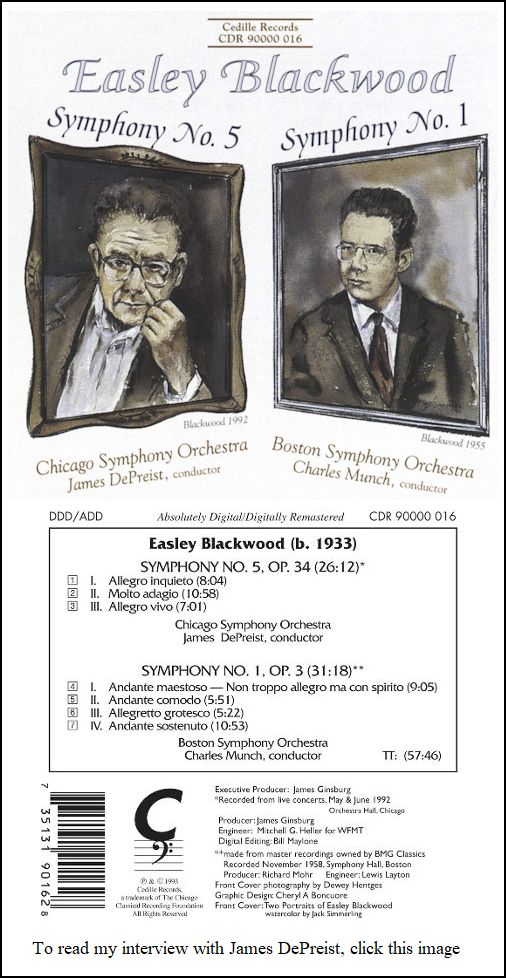 BD: Are they afraid of what you’re
doing?
BD: Are they afraid of what you’re
doing?
EB: I don’t think they’re afraid of it, but it goes contrary to their notion of historical inevitability. They feel that anyone who departs from the Marxian ideal somehow is not only wrong, but reprehensible. But I think they are intellectually dishonest because I can’t help but think that if they didn’t know when the piece was written, they would have a different response to it. So these people are not so much trying to evaluate the music or enjoy it, or for that matter, criticize it. They are trying to control the direction of music history.
BD: Then regarding your Fifth Symphony, which was just done by the Chicago Symphony Orchestra, would you object if it had perhaps come out — even fraudulently for a time — as an unpublished work of a known composer?
EB: No, but that wasn’t what I was consciously trying to do. What I was trying to do in that piece was come up with an idiom that I think Sibelius or Vaughan Williams might have discovered if they had experimented with modernism in 1915. I find it much more stimulating and amusing to write in an old-fashioned idiom — a tonal idiom — than a non-tonal idiom. It’s much as the difference between composing poetry and composing prose. When you write in a tonal idiom, you want it to rhyme and scan. You think about how it comes out in eight bar phrases or four bar phrases, or how occasionally there is a deliberate irregularity in the phrase length to produce a surprise. Certain modulations sound absolutely natural; others produce surprises; still others produce bigger surprises, and some produce outright shocks. All of these have their proper place within a context, and in the process of looking at how expert composers manipulate these things, it’s hard to say whether they were consciously aware of what they were doing. Certainly, when you look at it in this light, you can see how surprises are deliberately created.
BD: Do you feel that music is a continuum — or perhaps several continuums moving alongside each other?
EB: There are periods in music history where there’s a surprising unanimity of style and there are other periods where there are two distinct styles that are co-existing. There’s a surprising unanimity among composers in 1795-1800. Mozart, Haydn, and Beethoven tried to flatter the common idiom by writing pieces in it. They each wrote six quartets trying to write in the common idiom. I also have the impression that there was unanimity between the classical music and the popular music idioms in 1820 or 1825. As Schubert sat in the coffee houses writing his songs, he was listening to popular music that was in the same idiom. It was just missing the formal intricacy.
BD: Then, where did popular music split off from concert music?
EB: I don’t know my music history well enough to pinpoint it, but I can say that at present, it has diverged mightily.
BD: Is that a good thing?
EB: No. I don’t think that’s good. It was much closer in 1940.
BD: Jazz symphonies, and so on?
EB: Well, the jazz that was written in 1930s and in the ’40s, really had harmonic intricacies in it. They used change of dominance through the circle of fifths, with complicated altered chords over everyone harmonizing interesting melodies that were in yet another different harmonic mode.
BD: People who listened, though, didn’t have to understand that — they just heard it?
EB: They just heard it, and it was compelling and expressive. At the same time, orchestral music was being written, and there was a big diversity. Radicals and conservatives were operating practically from 1910 until certainly 1960, and apparently conservatives were operating all through the ’60s and ’70s, but being largely ignored.
BD: The Menotti types?
EB: Or the Walter Piston types or Roy Harris types or Vaughan Williams types. [Note that Piston is the only other American composer to be included in the anthology shown below! Volume 1 has works by Beethoven, Brahms, Haydn, Chausson, Franck, and Schumann.]
BD: I only bring up Menotti because it just seemed like he would write things that nobody liked — except the public!
EB: Yes, that’s true.
BD: And he was always maligned by the critics.
EB: Yes, he was... Well, not all the critics, but take Edward Rothstein as an example. He is certainly of the opinion that if the public likes it, it must be no good. For him, music must be post-Schoenberg, it must be post-Webern. He must see some kind of Hegelian sense of support there, and thinks that at long last, when the tyranny of harmony is liberated, music will then live in some kind of a bucolic Utopia.
BD: Is he confusing music with politics?
EB: I think he’s proceeding from some kind of a Marxian ideal which gives rise to this same false political theory.
BD: Then let me ask the big philosophical question — what’s the purpose of music?
EB: I think the overall purpose of music is to entertain and please.
BD: Nothing more, nothing less?
EB: Nothing more, nothing less. It provides high class entertainment to a relatively small audience of people who are tuned into it.
BD: What about the rest of the people who don’t fall into the relatively small class of people who are tuned in?
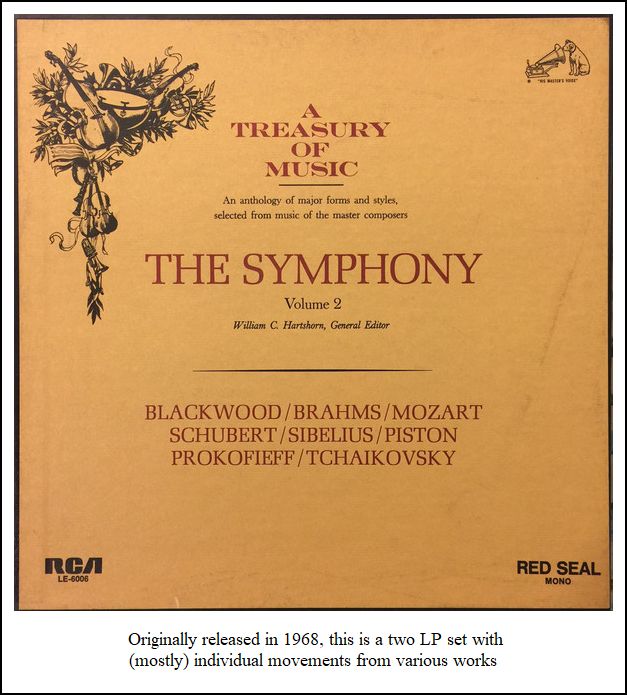 EB: Well, they don’t
get it.
EB: Well, they don’t
get it.
BD: Should they not be helped to get it?
EB: I don’t think that there
is much that you can do in that regard. I know very, very few converts.
Most of the music lovers I know liked it immediately. They may
have heard absolutely nothing until they were in their middle teens.
I’ve run into a number of undergraduates at the
University of Chicago over the years who became music lovers all of a
sudden in one fell swoop at age sixteen or seventeen. They heard
a Mahler symphony or a Verdi opera. Usually it’s
big orchestral pieces that catch the folks in their teens.
BD: Perhaps a Tchaikovsky 1812 Overture at the end of a Fourth of July concert?
EB: More likely the Fifth Symphony, or the march in the Sixth Symphony, or a piece like Respighi’s Feste Romani, or a Beethoven Seventh. Usually, it’s a big splashy exciting piece, and they go on from there and work into the subtleties and get into the less bombastic things. They get into Brahms and Beethoven and Mozart, and then they find their way into chamber music.
BD: What about the rest of the people? Should we try to get to them, or just to hell with them?
EB: [Chuckles] Well, I can’t say to hell with them. There’s always the possibility that someone will have a sudden change in taste, and suddenly hear some meaning in a work that hadn’t been heard before. I know full well at this point my ears and my taste are not like they were when I was a kid.
BD: Not better or worse, just different?
EB: It’s different. In some ways I can trace it. I started piano when I was four years old and had perfect pitch immediately. I remember thinking all through my early teens that since I was able to recognize every note as it went by, that I must be hearing everything. I remember one day in Boulanger’s class — this must have been about 1955 or 1956 — she stopped a student at one point and said, “What key are you in?” The student was perplexed and couldn’t be sure. Then she said, “What kind of a chord are you playing right here? Just what is that succession of chords that you just played?” The student replied, “Well, I just played a German VI followed by a I, VI, IV.” She said, “You see, you do know what key you’re in.” Then I thought, “Hey, that’s interesting. That fellow identified what key he was in not by knowing all the notes he heard, but by a chord progression.” I suddenly realized, “Wait a minute, I’m hearing all the notes, but I’m not hearing the chord progressions.”
BD: So, a real musician must come to it from both angles at once?
EB: It certainly is helpful. But after teaching harmony for 35 years, I can hear the chord progressions. The other night, just for fun, I switched on the radio and heard the slow movement of the Jupiter Symphony of Mozart. I hadn’t thought about the piece for a while, but I found that as I listened to it, I could identify every chord as it went by. I could hear the piece go I, V of ii, V of v, V, V of iv, perfectly clear knowing what it was. At an earlier time I would’ve been able to figure it out. but as it was, it went by and I heard it. Now, perhaps having this ability at this point has kind of changed my perspective on atonal music.
BD: This, of course, then allows you to look at the structure of music.
EB: You can see the structure. You can see the way the form is interrelated with the modulations and the key changes, and where the modulations are immediately conclusive, whether they’re ambiguous and then corroborated, whether they’re ambiguous and not corroborated, and then departed from right away, whether the new tonic is actually played in a strong beat or not, or how long it’s delayed. It seems to me that there are just many, many more subtleties here than you find in the kind of prosaic gestures that are essentially associated with non-tonal music which I was always trying to get around in my own atonal music.
BD: You were always trying to impose a good structure on something new?
EB: I was trying to impose a good structure and a sense of harmonic motion, plus changing modality, or, in some cases, changing rhythmic modality.
BD: But I trust you don’t disown any of those pieces that you wrote back then?
EB: Oh no. Well, some of them are no good, I’ll frankly admit that. Some of them are miscalculations, too, as far as sonorities are concerned. What sounds like a grand dissonant aggregate in the piano is a shrieking discord if it’s played with a brass section over a clattering of percussion instruments.
BD: But you obviously thought it was right when you were writing it.
EB: In some cases, there was a true miscalculation about the sonority involved. I was perhaps infatuated with how much fun it was simply to sit and put the piece together from component parts without being sufficiently aware of what the overall sound was. That, too, has advanced with the years. I can, at long last, look at an orchestra score of an unfamiliar piece, and hear it in my mind’s ear – not simply as an abstraction.
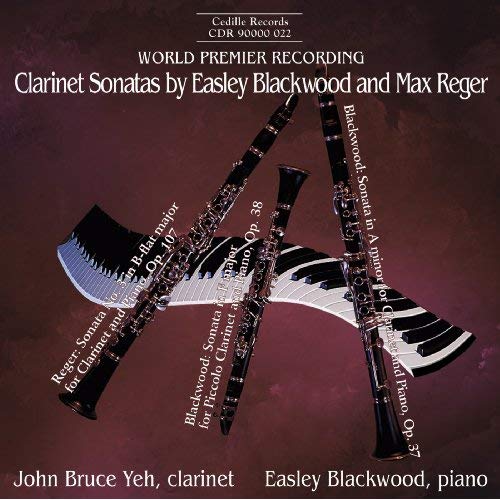 BD: You hear the colors
and everything?
BD: You hear the colors
and everything?
EB: I actually hear the colors. I hear how it’s spread out across the stage. I hear the echo in the hall. Right now, if I want to, I can hear the sound of Yankee Doodle being played by an oboe accompanied by a harp on the stage at Orchestra Hall with the hall empty or filled... or any hall that I’m really familiar with.
BD: Do you take this into account, then, if you’re writing a piece for the Chicago Symphony at Orchestra Hall?
EB: Yes, definitely. [Vis-à-vis the recording shown at left, see my interview with John Bruce Yeh.]
BD: Does that then preclude a performance by the Cleveland Orchestra in Severance Hall?
EB: No, it doesn’t preclude it. But if I were going to write a piece for the Cleveland Orchestra, I would want to hear a number of Cleveland Orchestra concerts in Severance Hall. Better yet, rehearsals. You learn even more from rehearsals.
BD: Because the works are torn apart and you can hear bits and pieces of them?
EB: Yes, and you can hear how it goes together.
BD: So, in other words, you would really not want to write just an orchestral piece.
EB: I could, but if I wrote an orchestral piece at this point, I’d hear Orchestra Hall.
BD: So it makes a significant difference, then, the orchestra and the hall?
EB: Oh yes it does. No question about it.
BD: Then that comes out as different notes and different textures in your piece?
EB: It comes out in different textures and different balances. It will also influence the conductor and what tempo to take. You can’t fine tune the conductor!
BD: [With a gentle nudge] Would you like to?
EB: No. It does not pay. You give the score to the conductor, and he then has to frame an interpretation and project his interpretation to the orchestra, which then executes his interpretation of your work.
BD: How much leeway do you build into the score?
EB: Lots.
BD: So there are many right ways of playing a certain piece?
EB: Yes, there are. Composers sometimes say, “Play only what I have written. Exactly that. No more, no less.” I think that they are wrong. The composer can’t control the interpretation of his work.
BD: Are they wrong, or just short-sighted?
EB: Both. And I am aware that Stravinsky said that, and he changed his mind in later years, too.
BD: Aside from what we’ve been talking about, how much changing of mind has there been in Easley Blackwood as you approach your 60th birthday?
EB: Lots and lots and lots. My taste has changed over the years, and my interests have changed. I’ve particularly become fascinated in the evolution of modernism from, say, 1910 to about 1930, and I’ve recently gotten acquainted with a large number of obscure works in that period. It’s partly because of this newfound ability to read a score, and I have found some absolutely stunning pieces.
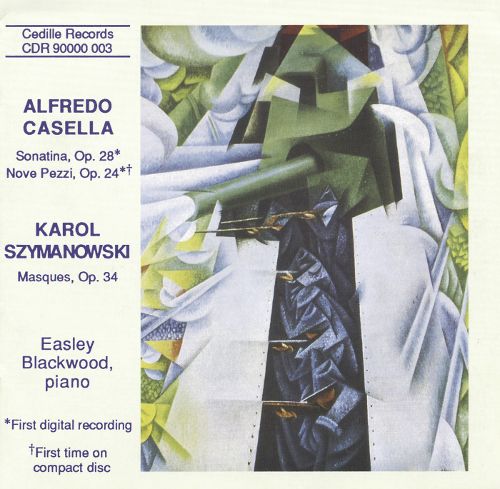 BD: Such as the Casella
which you’ve recorded?
BD: Such as the Casella
which you’ve recorded?
EB: Those are some of them. The Casella
Five Pieces for String Quartet are better than the Stravinsky
Three Pieces for String Quartet – more intricate, more obscure,
of course. I’ve never heard them. Prokofiev’s
ballet, Le Pas d’acier is
an absolutely complete knockout. It’s one of
these industrial ballets. At one point, the dancers are actually
prancing around on the half-completed building with cranes lifting girders
in place. The factory scene is interesting too. There’s
another one where the dancers are prancing around the white-hot ingots on
the floor of the steel mill with a blast furnace in the background.
The action is very clear there. Now, if you look at that piece and
then look at his Second Symphony, a lot comes to life with the Second
Symphony which looks like extracted bits from the ballet. There
is a fantastic mechanistic ballet by Carlos Chavez called El Caballos
de Vapor. It’s a completely obscure piece
which uses very, very interesting polyrhythmic techniques for orchestra,
too. It would take a very expert orchestra to play it.
* * * *
*
BD: Coming back to your music, if someone decided to use this Fifth Symphony as the basis of a ballet...
EB: [Interrupting] Fine. I go along with it.
BD: Even if they were making some kind of political statement upon it?
EB: Perfectly good. No problem. An old friend of mine with whom I’ve kept contact with for a long time — a nuclear scientist and a good amateur musician — just happened, by coincidence, to be in town during one of the performances the CSO gave of my Symphony #5. At a little dinner party afterwards, he said, “You’ve been listening to a lot of ballets, haven’t you?”
BD: Was he right?
EB: He certainly was. He can pick up a subtlety like that. Some years ago, another old friend listened to one of my very early atonal polyrhythmic pieces — a piece for flute and harpsichord. He was not a knowledgeable musician, but he had a large record collection and he really enjoyed it. He listened to the piece and after it was over, he said, “You know, I can’t escape the impression that you choose every note in that piece in such a way to produce the maximum possible surprise.” I thought to myself for a moment, and concluded, “Uh-oh... he’s right! That is exactly the process I use.” I never wrote another piece like that again. If someone can spot that just listening to it, then it’s too obvious.
BD: You don’t want to be obvious?
EB: I don’t want to be obvious. I want subtleties to be there.
BD: Do you want to give obvious pleasure?
EB: Yes, I do, but I want there to be subtleties above and beyond that. If it gives obvious pleasure and there are no subtleties, you’ve got a piece like Orff’s Carmina Burana.
BD: That one just hits you in the gut.
EB: It hits you in the gut, and you listen to it five times and that’s the end.
BD: And yet, some people listen to it 500 times.
EB: I remember when I first heard it I was absolutely swept off my feet. This must have been about 1958. I listened to it immediately again, and then listened to it every day for four days and then that was the end of it. Never heard it again. Never wanted to hear it again.
BD: That was 35 years ago. Would you want to hear it again now?
EB: Oh sure. But it lost my attention at that time. There are no subtleties in it.
BD: I wish you had heard it last night so
that you could say if there were some things that you missed, or any change
in your own idea that has made you look at it differently. 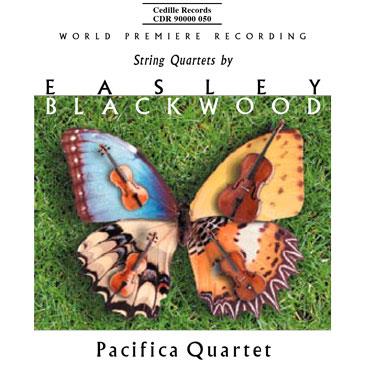
EB: That’s entirely possible. That could happen. But take a piece like the Beethoven Opus 59 #1 Quartet. That one, I find, sounds wonderful when you first hear it. Actually, I admire #3 more. That one sounds grand when you first hear it, but it’s even better the second or third time, and when you get to know it really well, you find out that there are some really extraordinary subtleties in it.
BD: Is this what makes a piece of music great — the fact that you can delve into it and delve into it and never reach bottom?
EB: That’s a huge component of it. Another thing that helps is if the initial experience is attractive enough to make you want to hear it again. In some cases, the initial experience may be so baffling that only connoisseurs go on. This is the case with some of the late Beethoven string quartets. But for me, it’s certainly not the case with a piece like the Brahms D Minor Violin Sonata. That one makes a very positive initial impression, and when you get to know it better, you realize that there are intricacies in it that you missed the first time around. Now try to pull it apart and find the modulations and find out just what key it’s in at any given moment.
BD: Did you ever figure it out?
EB: Well, I see two or three different interpretations of it. As is often the case with music that has lots of modulations, you can either hear many modulations, or else you can hear that the overview is all in one key and this is simply degrees in that key that are being stressed out all in the secondary dominants with subdominants. An overview will give you one idea, but if you’re just advancing from bar to the next pretending you don’t know the piece or how it’s going to come out, you have a different impression. Now, for me as an interpreter, the question comes up — which way do you play it?
BD: It would mean different stresses.
EB: Yes it does, and I’m inclined to play lots of modulations. It just gives a more vivid inflection.
BD: You’ve played your own pieces and pieces by other composers. Do you find that you react differently to pieces by other composers, great and lesser, than if you were just a performer and not a composer?
EB: I can’t be sure. The whole thing is so intertwined at this point. At least in this country, I must be about the only example there is of that old-fashioned entity known as a composer/pianist. There are other composers that play very well. Charles Wuorinen certainly plays very well, but as far as I know, he doesn’t play standard repertoire. I haven’t heard of him playing anything except his own music for quite a while. A week from Sunday, I’m going to play a trio of mine — one of the atonal polyrhythmic pieces — but also the Ives Trio and Copland’s Vitebsk. A few months ago, I got to play the Schubert Trout Quintet in the program along with the Stravinsky L’Histoire du Soldat Trio. Shortly after that, I did a program with the Pro Musica that included Pierrot Lunaire of Schoenberg, also a piece by Boulez, and another run through of that Stravinsky piece. Last year, with some very good students on campus, we did the Schumann E Flat Major Piano Quartet and the Brahms F Minor Quintet.
BD: Then let me turn the question around. I’ve asked you about the composer influencing the pianist. Because you play all of this repertoire, does that influence you, the composer?
EB: It certainly influences my piano writing, and I can see this in the music of other pianist/composers. They write for their own hands. They write for their own technique.
BD: Rather than writing something and hoping someone can cope with it?
EB: That’s right. You can tell how large a composer/pianist’s hand is. Mozart could make an octave, but no more. Beethoven could stretch a tenth, but couldn’t play it forte. Rachmaninoff could stretch an eleventh at least. Liszt could stretch a tenth. Liszt could crash down on A and C sharp in the left hand, but you don’t find so many tenths in the right hand.
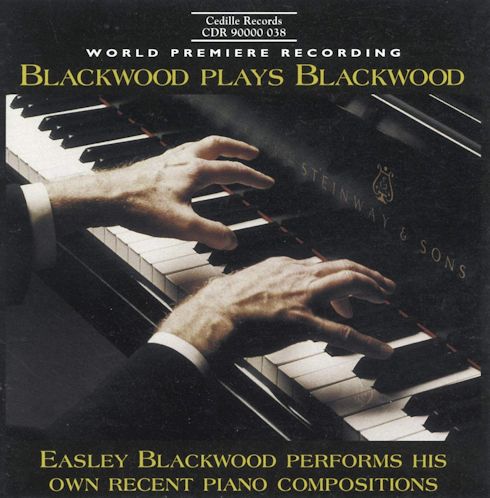 BD: So, you have to have hands similar to theirs
in order to really cope with these pieces?
BD: So, you have to have hands similar to theirs
in order to really cope with these pieces?
EB: Or larger! At least as big. Some composers have a tremendous facility with trills. Other composers have a tremendous facility with double notes.
BD: So, the hands have to be at least as big. Does the pianist have to be at least as smart as the composer to really get into the music?
EB: I wouldn’t say ‘smart’. If you play it without a really intelligent musical instinct, you just get a very superficial reading which may not be ugly in any way, but it doesn’t seem to communicate very much. Someone who just breezes through the Chopin Etudes may be superficially very impressive, but there are subtleties in the harmonic idiom that go above and beyond simply whizzing through them.
BD: Sticking with the Chopin for just a moment, shouldn’t a pianist start with a superficiality, and eventually try to get into it and more and more, rather than starting where Rubinstein left off?
EB: Yes. That’s certainly the case. With pieces like the Chopin Etudes and many real knuckle busters, you’ve got to start playing them before you can really play them. If you don’t learn those pieces in your middle teens, you can never play them. Chopin Etudes are cases in point. Those are not user-friendly for me. I could never play them in my teens, and I don’t play them now. I just don’t feel comfortable with them. On the other hand, I learned the Beethoven Opus 101 in my teens, and I still don’t feel comfortable with it. I never will, but at least I can play it. The Schumann Fantasy is another case in point. The Brahms F Minor Sonata is another case in point. My teacher once said, “You cannot play these pieces, but you must learn them now. If you don’t attack them now, you will never get them.”
BD: And he was right?
EB: He was right.
BD: So, then, you’re advocating that if someone decides when they are eight or nine or ten years old to be a concert pianist, you’re saying throw everything at them right away?
EB: [Laughs] Well, you can’t do it when they’re eight or nine. You have to wait until the hand is mature.
BD: Fourteen then?
EB: Fourteen, that’s right.
BD: Then throw everything at them before they’re twenty.
EB: Well, find out what they seem to take to at that point, and concentrate on that. Don’t concentrate on what seems to be a challenge.
BD: Then is it a mistake for a mature pianist to try to expand his or her repertoire?
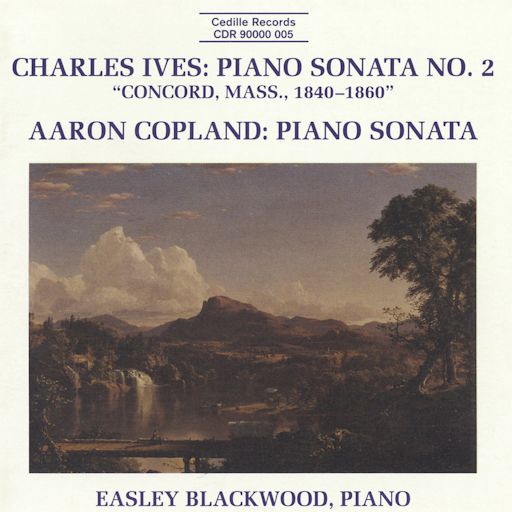 EB: No it’s not, but you
have to be very careful because if you expand in the areas where other
people are experts, the difference is going to show. I’m
willing to expand in the areas where the repertoire is really obscure
— like the Casella and Szymanovski pieces. But actually,
I knew the Casella Sonatina when I was fourteen.
EB: No it’s not, but you
have to be very careful because if you expand in the areas where other
people are experts, the difference is going to show. I’m
willing to expand in the areas where the repertoire is really obscure
— like the Casella and Szymanovski pieces. But actually,
I knew the Casella Sonatina when I was fourteen.
BD: When you play Ives, do you feel like you’re competing with other performances?
EB: Oh yes. Oh yes. And where the Copland is concerned, I’m competing against Leonard Bernstein’s recording. Jim Ginsberg [the producer of Cedille records] and I discussed all these matters before he was interested in putting out the disc. We had long discussions before doing the Ives. He said, “Here is the recording of the Ives that has got the most favorable notices from the best, sensitive critics. What do you think? Can you do better than this?”
BD: Do you have to do better?
EB: Yes, you do. There’s no point in recording a piece that’s got six different recorded versions unless you are sure that you can do it better, and that means, all egocentricity aside, that you can hit all the notes right — after you re-record and edit enough — and that you know inflections about the phrasing and idiomatic things in the piece that elude the other players.
BD: Does this necessarily mean that it has to be different?
EB: In the case of that piece, it does. Most of the recorded versions I know don’t appreciate the ragtime elements in the second movement, and don’t realize how sharply the syncopations have to be inflected. There is an unfortunate spot in the second movement of that piece which is really, as far as I can tell, unplayable as it’s written. It involves very complicated, intricate figures with the double note figures. In the first edition of the Sonata, that was always over the same four notes. But in the revised version in the 1940s, that has been changed around so that sometimes it’s white notes and sometimes it’s black notes. At the same time, there is a very fast hand crossing asked for. The left hand crosses back and forth across the right hand, and I have never heard anyone play that correctly.
BD: Do you get it right?
EB: Yes, but I re-distribute the hands in such a way so as to eliminate the hand crossing. I’m playing the notes that are written.
BD: [Emphatically] Well, that’s your job — to play the notes that are written! How you accomplish it is irrelevant.
EB: That’s right. No one has spotted that. A pianist who knew the problem there, who listened very closely to my recording of it would say, “Yes, he’s redistributing the hand parts there.”
BD: There’s no thought that maybe Ives wanted it to sound messy, and so he wrote it just a little bit beyond any possible technique?
EB: You can’t be sure. He sort of hints at that in some of the comments he has made about the piece. But it sounds so much better when you play it right.
BD: Really??? Better than smearing it his way?
EB: Yes. It is much more convincing.
It’s smeared up in the writing. If you play
it exactly as written, it sounds smeared in precisely the right way.
If you smear it above and beyond what’s written,
it simply sounds out of control, and it begins to weaken.
BD: You mentioned a minute ago about getting all the editing done and seeing that all the notes are right. If you have to edit a performance to get all the notes right, does that make it a fraud?
EB: No, it doesn’t, but you have to be very careful just how far you go with this. If you over-dub, then you’re committing fraud. Suppose you win a Grammy for your finest piano performance and it turns out later on that you’ve been over-dubbing. That is just one step shy of lip-synching.
BD: So the editing process is really just if you had gotten all the notes right in one performance. You’ve gotten them all right sometime and you’re just picking out those sections?
EB: You’re just picking out the sections where you got it... although, one wonders how much editing is legit and how much is not. Another thing that’s possible with modern technology, is to record the whole thing at 75% or even 90% of the correct tempo and then speed it up. That’s not legit. That you must not do.
BD: Should there, perhaps, ever be one technically-perfect recording just to hear it with all the notes in the right place and no pianist credited?
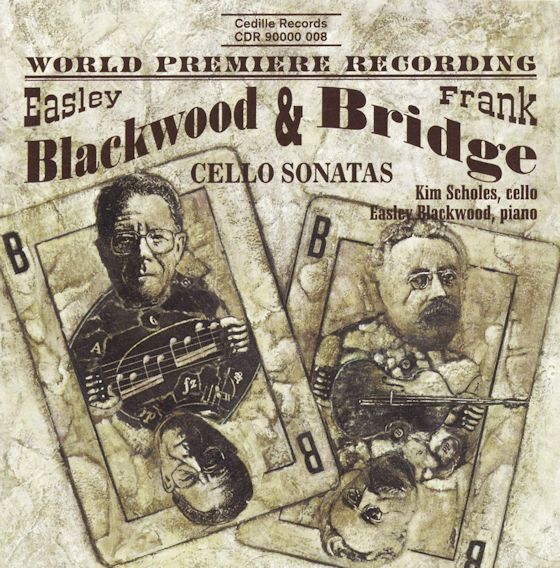 EB: That’s
an interesting question. It is now possible, using the synclavier,
to do an electronic simulation of just about anything there is. I
recently connected with that technology. Some years ago, I wrote
a piece for steel band. I was judge of the bi-annual Steel Band Competition
in Trinidad for several festivals in a row, and I got very familiar what
steel bands can do and play. So, I wrote a piece about 4 and a half
minutes long. They never played it. Obviously, no contestant
could enter that piece with me sitting there as a judge. That’s
not proper. But I have in my possession an electronically simulated
version of that steel band piece. I don’t know
whether it’s close enough to fool anyone, but it
certainly gives me an idea what the piece sounds like that I could not possibly
of had before.
EB: That’s
an interesting question. It is now possible, using the synclavier,
to do an electronic simulation of just about anything there is. I
recently connected with that technology. Some years ago, I wrote
a piece for steel band. I was judge of the bi-annual Steel Band Competition
in Trinidad for several festivals in a row, and I got very familiar what
steel bands can do and play. So, I wrote a piece about 4 and a half
minutes long. They never played it. Obviously, no contestant
could enter that piece with me sitting there as a judge. That’s
not proper. But I have in my possession an electronically simulated
version of that steel band piece. I don’t know
whether it’s close enough to fool anyone, but it
certainly gives me an idea what the piece sounds like that I could not possibly
of had before.
BD: Is there any end to musical possibility?
EB: Oh, eventually there is, but we’re not there yet. At this point, I am persuaded that the tonal and harmonic resources of the twelve-note equal scale have, in fact, been discovered and exploited. I think that’s something that only came true in about 1965 or 1970. After that, it’s been some kind of a rehash of what’s been done before. So, the last frontier to be breached is the atonal polyrhythmic idiom, and there’s a vast repertoire in that idiom that begins somewhere around 1948, just to pick a random year,
BD: But I thought you said that this was dead!
EB: Well, it’s dead now. It went on till about 1965. There’s a huge repertoire written at that time, and I’m a participator in that. I remember being confident that the techniques that are needed to play polyrhythms accurately would eventually be part of any good professional musician’s standard training. It did not happen.
BD: Will it ever happen?
EB: I don’t see it at this point. It’s confined to a few specialists. Thank heaven Sharon Polifrone [violinist] and Kim Scholes [cellist] can do it so we’ll get a very accurate sensitive reading to my Trio. But most players can’t, and composers who insist on writing that way for orchestra are going to get a very rude shock when they find that the string section can’t play it in unison.
BD: So, they’re writing things that cannot be played and probably never will be played, and they will be lost in the recesses of history?
EB: That’s right. You hear orchestras trying, and it sounds terrible. It’s terribly embarrassing to the orchestra. But certain things that are playable with a small group of highly specialized chamber music players in that idiom are simply not available for orchestra.
BD: Should they be?
EB: In the ideal, yes. But when good conductors audition string players, they are not interested in how accurately they can play seven while the conductor beats three.
BD: They want a nice long line for the Beethoven symphonies!
EB: Well, more than that. They want
to be able to summon huge volumes of sound so they’re
not drowned out by the brass in the last movement of Tchaikovsky’s
Fifth.
* * * *
*
BD: Coming back to your own music now, I assume you are asked for many, many pieces. How do you decide if you will accept a commission or turn it aside?
EB: Oh, it depends to some extent what kind of rapport that I seem to have with the players or with the commissioning agency. When someone is interested in a new piece, the first question I ask now is what kind of idiom would they like it to be in? At this point, I feel comfortable in such a variety of idioms. If someone said to write an atonal polyrhythmic piece for four strings and four winds and piano, I’d be tempted to go back into that. On the other hand, if someone said just to write an idiomatic piece for flute and guitar — which has recently happened as a matter of fact — I’d say I’m inclined to write in a tonal idiom which will sound, to some extent, like Baroque or Classical — at least in the rhythmic arrangement — but it will have some chord progressions that are more associated with Sibelius, Rachmaninoff, or Franck.
BD: Do you think that we’ll ever find a time where this kind of idiom takes off, and more people accept this, and music history becomes, then, a continuum with about a 50 year gap in the middle?
EB: It begins to look that way, although I don’t think there’s ever a gap. Reactionary composers have been operating right straight through, writing pieces which are obscure. There are composers in Europe, too, who have written six and seven symphonies over a long period that sound something like Strauss and Elgar.
BD: So, you think there is still promise for progression, but just in this different direction?
EB: That’s my guess.
BD: Are you optimistic about the future of music?
EB: Oh yes. I certainly don’t think that this mass of atonal polyrhythmic music that’s around is all bad. Much of it is too repetitive, and just shows just how limited the idiom is. That’s part of the problem. A few months ago, I got out a recording of a piano recital I played 25 years ago. It contained nothing but atonal polyrhythmic pieces. The first piece in the program was a set of Three Short Fantasies that I wrote in about ’63. Then a piece by John Perkins — a piece that I commissioned, written also in about 1963.
BD: Is that the one that showed up on the
CRI record?
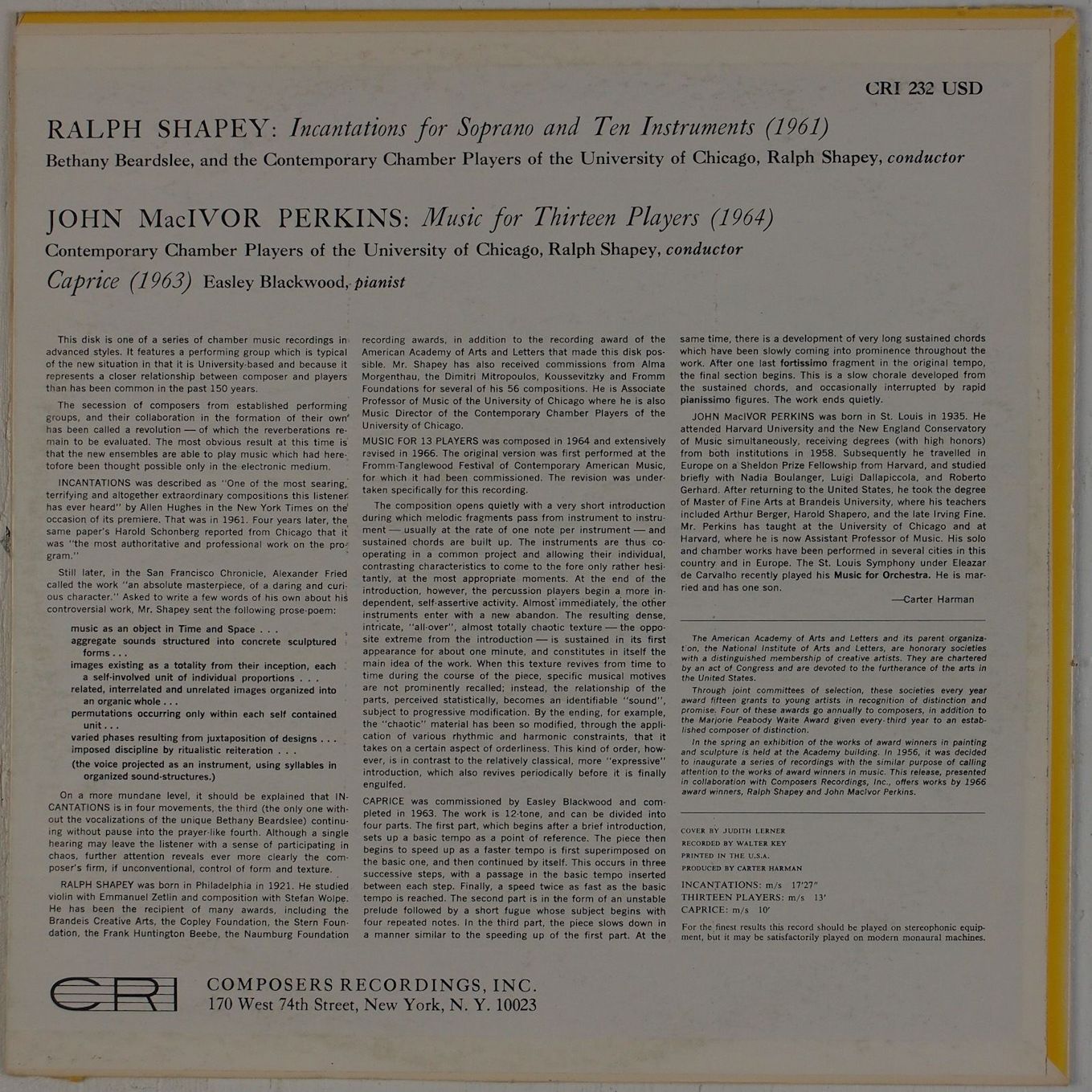
See my interviews with Bethany Beardslee, Ralph Shapey, Paul Fromm, Arthur Berger, and
Harold Shapero
EB: That’s right. That’s the piece, and a piece by Charles Wuorinen — his Piano Variations, again, written in about 1963. Then after intermission, is the Boulez Second Sonata. Now I have not played any of those pieces in many years, and to a large extent I’ve forgotten them, but I was struck as I listened to that whole recital as to how similar they all were. The differences are really a matter of subtlety. If you listen carefully and know what to listen for, you can tell they’re by four different composers, but, oh, are they similar!
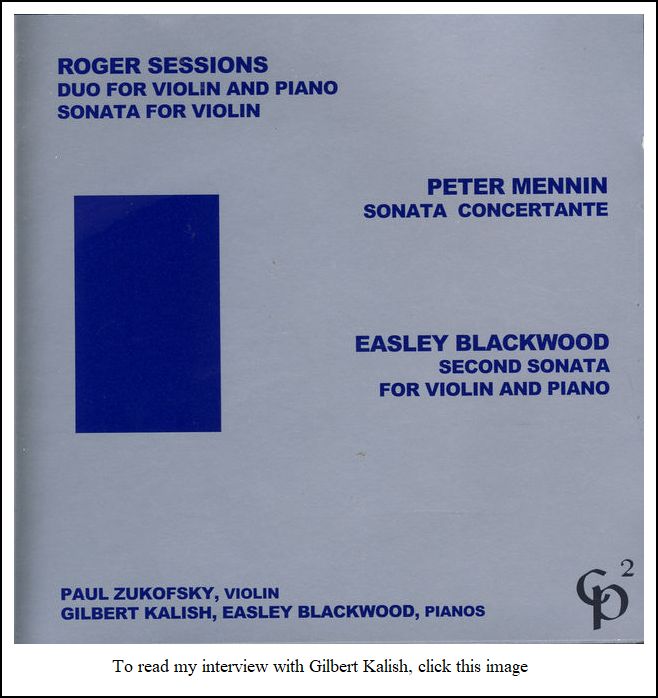 BD: Is this to say that
they were all mucking in a morass, or does it elevate the Perkins up
to the level of Boulez?
BD: Is this to say that
they were all mucking in a morass, or does it elevate the Perkins up
to the level of Boulez?
EB: [Laughs] Well, it doesn’t
necessarily elevate it, but shows it as a representative piece of the
same idiom. Every note produces a maximum possible surprise.
There are constant polyrhythms going on. A large part of the formal
organization of the pieces has to do with the rhythmic modality, but the
gestures, if you will, tend toward great similarity. Those pieces
are all abstractions. When you get atonal pieces that are actually
dramatic pieces — and this is true in many of the
abstract pieces as well — then the level of expression,
again, becomes very similar, and the pieces tend to depict the ravings of
a madman, various types of degradation, mayhem, perversion. I’m
talking about pieces like Lulu, Erwartung, Pierot Lunaire,
the Schoenberg Five Orchestra Pieces.
BD: When you are working on a score — in whatever idiom — and you get back and you tinker with it a little bit, how do you know when to put the pencil down and say, “It’s ready. It’s done. It’s finished.”?
EB: I don’t make extensive changes. For an orchestral piece I write in a short score. I find that I can get everything on three staves — treble clef, alto clef, and bass clef. The thickest texture you want to hear from an orchestra you can get down that way. Now, as soon as I have enough measures of the short score done, the next thing to do is get out the full score page and write the whole thing down. Then, except for very, very minor, slight changes in dynamics and so forth, that’s the final version.
BD: You essentially just write it right through?
EB: Yes. Just write it right through.
BD: And it’s done?
EB: And it’s done. There’s hardly much of a chance to experiment and revise an orchestral piece. With a solo guitar piece, you have to confer with the guitarist — especially if it’s in a conventional idiom — because you can facilitate the parts sometimes by just taking one note out of a chord, and very, very little is lost as part of the sonority of texture is concerned.
BD: Because the missing note is probably doubled someplace?
EB: The note may be doubled someplace else, so it’s useful, when you’re writing a solo virtuoso piece, to be in contact with the player and be sure that you’re not overestimating. But I very seldom go back and make inserts or make cuts. I try to get all of that right just as I’m going. I may go back the day after and make a little change, but I won’t make changes weeks after.
BD: You mean after the performance?
EB: No, after writing the passage.
BD: Oh, I see. It just comes out full-blown.
EB: It comes out full-blown.
BD: Has it gestated in your mind for a long time?
EB: Sometimes yes, sometimes no. As to the Fifth Symphony, I knew for several years how the piece was going to begin, and I knew about 30 seconds in. After that, it’s coming back to the composing table every day and saying, “Good God! How do I go on from here? Will I be able to get an idea or won’t I?”
BD: It wasn’t self-evident?
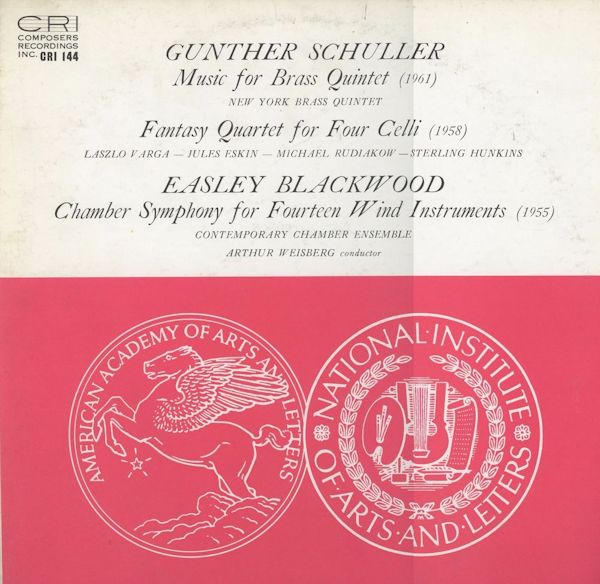 EB: It was not self-evident.
Then I left a substantial amount of time between the first movement and
the second movement because I wanted to be sure that there was a stylistic
difference between the two. I remember very well that I had absolutely
no idea how I was going to start the second movement. A week went
by and I had to start it on Monday. What am I going to do? Well,
Sunday at dinner I was thinking about it, and no beginning comes to mind.
Here I am finally that Monday morning sitting ready to start. What
do we do? There I am with the treble clef and the alto clef and
the bass clef before me, and there is the blank three-staff short score.
What do I do? I said, “Okay, I’ll
start with a half diminished vii chord in first inversion in E flat minor
and follow that by V.”
EB: It was not self-evident.
Then I left a substantial amount of time between the first movement and
the second movement because I wanted to be sure that there was a stylistic
difference between the two. I remember very well that I had absolutely
no idea how I was going to start the second movement. A week went
by and I had to start it on Monday. What am I going to do? Well,
Sunday at dinner I was thinking about it, and no beginning comes to mind.
Here I am finally that Monday morning sitting ready to start. What
do we do? There I am with the treble clef and the alto clef and
the bass clef before me, and there is the blank three-staff short score.
What do I do? I said, “Okay, I’ll
start with a half diminished vii chord in first inversion in E flat minor
and follow that by V.”
BD: And it worked? [Vis-à-vis the recording shown at left, see my interviews with Gunther Schuller, Harvey Phillips (Tubist of the New York Brass Quintet), and Arthur Weisberg.]
EB: That got it started.
BD: So, you couldn’t get an idea in the middle of the movement and work to the end and then see how it would’ve come to it?
EB: No. That one was just composed straight through. For the last movement, there was, again, an idea for that had been running around in my mind for years, and I knew the very ending of the whole piece. When I got about three fourths of the way through the movement, I got to the spot where I wasn’t sure how to go on. I could see several possibilities, so rather than worry about which one, I decided to compose that part where I knew how it was going to go, and that was the very ending. I then started composing backwards in eight or twelve bar fragments per day until I was just about lined up with the spot where I had stopped. Then the questions was how to connect the two. There’s a trick for doing this. There are three chromatic modulating sequences that occur just at that point which will connect absolutely anything to anything. I remember speaking with James DePreist, who had known the piece well, having conducted it four or five times. I confided to him just what had been done in the last movement and said, “Now you know the piece pretty well. Can you find the join? Can you spot the place that links what had been written up to with what had been written backwards?”
BD: Was he able to find it?
EB: No, he couldn’t find it.
BD: So, obviously it worked within what was going on.
EB: I don’t think anyone would be able to find it unless I pointed it out. At least it’s not one of those cases where a friend says, “You chose every note so as to produce the next maximum possible surprise.” [Laughs]
BD: Now that you’ve revealed this, are people going to listen to the recording and try to figure it out?
EB: I doubt it.
BD: You wouldn’t want them to do that?
EB: I wouldn’t mind.
BD: [Surprised] Really???
EB: It’s no secret. There was a spot in the last movement where I began to get the idea that I wanted to make some recalls in the first movement, and I had to pause a long time about that and say to myself, “Do I really want to do this or am I, in fact, just running out of ideas.” There are many well-known pieces in the repertoire that recall fragments from earlier movements. In some cases, the movement is a variation of an earlier movement. In other cases, material is brought back. but when it’s brought back, it’s not simply quoted. It has to be transformed in some way — as Cesar Franck does in the D Minor Symphony. That’s a particularly good example.
BD: It’s a recall rather than a reproduction?
EB: That’s right,
but a recall in a different mood, and likely in a different tempo.
The lovely English horn tune in the slow movement is recalled with blazing
fanfare in the last movement. So, it occurred to me that what I really
want to do is not simply present it in a variation — as
you find, for example, in the Bartók quartets or piano concertos
— but I wanted a transformation on it. Then, after thinking
that over really carefully, I said, “Yes,
I really do intend to do this. It’s not that
I’ve suddenly run out of new ideas.”
BD: You’ve done a lot of teaching over many years. What advice do you have for young composers coming along?
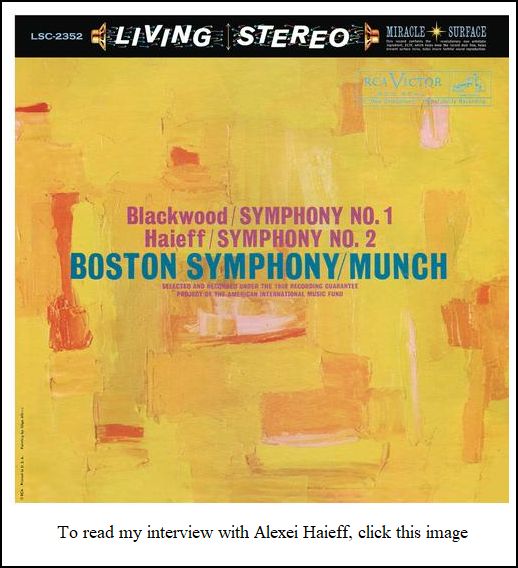 EB: I hate to say this, but it’s
not a very much fun profession.
EB: I hate to say this, but it’s
not a very much fun profession.
BD: Teaching?
EB: No. Teaching is something else.
BD: Oh — it’s the composing that is not a fun profession?
EB: Right. There you sit and think, “My God, how do I go on from here?” It really is an unsettling thing to have a piece half way done, and you’ve got to go back to it tomorrow and you’ve got to go back to it the day after that. Are you going to be able to go on? There are days when ideas come much faster than others, but there’s no guarantee that you are going to find the idea that you need.
BD: So it’s not that you have to go back to it day after day. You have to go back to it till it’s done.
EB: You have to go back to it till it’s done, and you may be on a schedule, too. There may be a performance down the line, and you’ve got to have the parts done.
BD: So you have to go back to it till it’s done, and it better be done by the first rehearsal!
EB: That’s right. And the parts had better be copied and proof-read and reproduced and bound and whatever else. Then you find something else. No matter what idiom you write in, every composer — at least from 1800 on — finds that there is a hostile faction out there that really hate you. They hate your music. They want to make you stop. They want to demoralize you. They want to make you believe that you’ve lost it.
BD: Even if you’re part of the intellectual musical mainstream?
EB: Yes. There are always other factions that don’t like it. Brahms was vilified, and Beethoven was vilified, and this goes on today. I find it works both ways. It always has. It doesn’t make any difference what style I write in.
BD: You really have to have a lot of tenacity just to keep going.
EB: You have to have a great deal of tenacity, and if you need encouragement, you’re not going to get it.
BD: So you just keep plugging away.
EB: You just keep plugging away. There also has to be some kind of a dedication to it.
BD: What’s the reward?
EB: The reward is that once in a while you hear a piece really well played, and the audience really likes it, and it does what it set out to do. It provided an array of intelligent cultured people with high class entertainment. It was well received by the orchestra, well received by the conductor — or whatever group of players — or you walk out on the stage and perform something yourself, and you bring it off and you get a reaction from the audience both from your playing and from your composition. So there are good moments, but there bad moments, too. There are moments where you hear something and you say, “My God. No. That’s not what I meant. I don’t like that.”
BD: Have you basically been pleased with the recordings that have been issued of your music since they have a longer-lasting, more universal appeal than a performance which is gone?
EB: Yes. Generally so. I’ve
been pretty fortunate that way. The majority of the recordings of
my pieces that are in the catalog, or have been in the catalog, have been
quite representative. Some more than others, but, by and large, there
are no klunkers.
========
======== ========
--- --- ---
--- ---
========
======== ========
For a brief but interesting essay by Easley Blackwood, click
HERE.
© 1993 Bruce Duffie
This conversation was recorded in Chicago on February 11, 1993. Portions were broadcast on WNIB two weeks later, and again in 1998, and on WNUR in 2012 and 2015. This transcription was made in 2001 and linked to New Music Connoisseur and posted on this website at that time. It has also been linked to the Classical Connect website. An un-edited audio copy was placed in the Oral History of American Music archive at Yale University.
To see a full list (with links) of interviews which have been transcribed and posted on this website, click here. To read my thoughts on editing these interviews for print, as well as a few other interesting observations, click here.
Award - winning broadcaster Bruce Duffie was with WNIB, Classical 97 in Chicago from 1975 until its final moment as a classical station in February of 2001. His interviews have also appeared in various magazines and journals since 1980, and he now continues his broadcast series on WNUR-FM, as well as on Contemporary Classical Internet Radio.
You are invited to visit his website for more information about his work, including selected transcripts of other interviews, plus a full list of his guests. He would also like to call your attention to the photos and information about his grandfather, who was a pioneer in the automotive field more than a century ago. You may also send him E-Mail with comments, questions and suggestions.